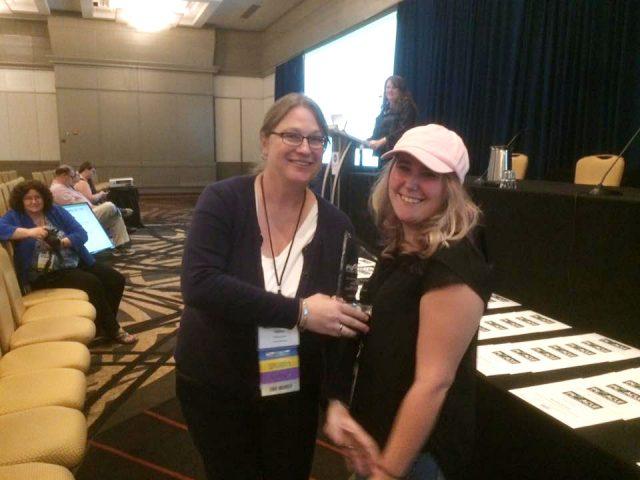By Macy Feemster/ reporter

Photo courtesy Elizabeth Beckham
NE students and aspiring artists got into the Halloween spirit Oct. 20 when Elizabeth Beckham talked about and showed her “creepy” large ball-joint doll photographs.
Beckham is The Neo Gallery’s featured artist until Dec. 1. Originally from this area, Beckham now attends Amarillo College.
“I take pictures of big creepy dolls,” Beckham told the audience.
It’s what she’s known for.
“I want people to feel a sense of community that they can get out of our photo department but also imagination, creativity,” said NE photo instructor Ting Huang, who worked with curator Mark Penland on the exhibit.
The dolls Beckham uses aren’t regular dolls children play with. In fact, Beckham keeps her dolls away from her children. She uses Asian large ball-joint dolls, whose prices can range anywhere from $300 to $1,000.
Beckham said she and her husband both play Dungeons and Dragons and Battle Tech and paint miniatures of their characters.
“One day in 2007 while I was looking for character pictures online, I found a picture of an Asian ball-jointed doll,” she said. “I fell in love with the picture.”
For two months, she searched for the perfect doll online. After narrowing it down to just two dolls, she finally made a decision. The day her doll arrived in the mail was also the day she bought her first camera, a point-and-shoot that she took everywhere.
After a while, she started getting used to shooting with the camera. She began searching for realistic clothing, eyes and wigs. Beckham learned to shoot from perspective.
Beckham joined the 365 Project, where artists take a photo every day for a year. She started shooting everything — her cat, beta fish and bugs. Beckham said she discovered she really likes textures, shadows, light contrasts and close-up images. She received her first DSLR camera for Christmas a few years later.
Beckham had lots of people urge her to go to school for photography, so she did. Amarillo College photography assistant professor René West became Beckham’s teacher and mentor.
When Beckham started getting her works with the dolls published, they caught many people’s eyes.
“I like her black-and-white pictures the most along with the close-ups,” NE student Samantha Day said. “Direct black-and-whites and the cyanotype pictures where she just did the clear ones were my favorite.”
Beckham’s artwork is displayed on the walls of the NCAB building in The Neo Gallery.
Huang said the NE program had wanted a gallery.
“Half of our hallway could be curated work from outside artists of any type,” she said. “It could be documentary. It could be photojournalism. It could be fine arts like Elizabeth Beckham, all sorts of photography. The other side of our hallway, the other part of The Neo Gallery, will be student work. That’s with the intention that the students will be able to write on the resume that they’ve exhibited in The Neo Gallery.”
There are many different ways to interpret artwork. Beckham’s artistic style varies from other artists.
“I would describe her style of work as free,” NE student Debora Wright said. “A free artist in her own zone, not worried about what people think.”
Students talked among themselves about their interpretations of the artwork. Beckham explained how she hopes people interpret it.
“I hope people feel disturbed after looking at my art,” Beckham said. “I don’t make art to make people feel comfortable. So if they feel uncomfortable, then I guess I’m conveying some of it, but for the most part, I want them to take out what they brought to it.”
Disturbed or amazed, the students said they enjoyed Beckham’s work.
“Sometimes the artists will deviate what they’re doing, but hers is very focused — for example, the dolls,” Day said. “It’s one model that she continues and expands on.”
Beckham’s strategy to getting inspiration for her artwork isn’t thought out and planned.
“Sometimes, I’ll have an idea or a general idea of a concept before I take pictures,” she said. “I come up with all of my ideas right before I go to sleep. I have a notebook right by my bed so I can write down my ideas. Or when I’m driving somewhere and zoning out, I’ll come up with something. Basically, whenever my brain is in idle mode, I’ll think of my ideas.”
No matter what method Beckham uses to create her ideas, she makes sure she does what she’s interested in doing.
“I’m focused on the dolls, and that’s what everyone is interested in seeing,” she said. “Sometimes, I do landscapes or macro or other types of photography, but people like seeing the dolls, and I like doing the dolls.”
Beckham said shooting the dolls is her favorite thing to do. It’s the obsession that keeps pulling her back. Beckham offered advice to beginners.
“Practice. You don’t get better at doing something by wishing that you somehow had talent. You can develop talent,” she said. “No. 1 thing that develops talent is practice. You don’t get better at taking pictures except by taking more pictures.”





























